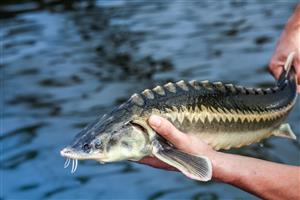- Main page
- News
PROTECTS STUCK FROM BACTERIAL DISEASE
11/25/2021
In recent years, the production of sturgeon in aquaculture has grown significantly due to the high demand for caviar on the world market. Sturgeon farming in aquaculture is one of the most important measures aimed at reducing the population and restoring the life cycle of sturgeon. However, the rapid development of aquaculture leads to an increase in diseases caused by bacterial infections, which in turn can lead to high mortality of sturgeon in aquaculture and catastrophic economic losses.
Sturgeons are one of the oldest species of fish, they mature sexually late and live long. And caviar and meat are important as an indispensable source of protein for the human body. Currently, sturgeon species are threatened with extinction due to high levels of poaching, water pollution and habitat loss. Therefore, their cultivation in aquaculture is organized. But it also has a negative effect. Although sturgeon are rescued from poachers, they are caught in the trap of infectious bacteria.
Amangeldy Bisenbayev - Director of the Research Institute of Biology and Biotechnology at KazNU, Academician of NAS RK, Doctor of Biological Sciences, Professor. Under the guidance of the scientist, "New antibacterial drugs for the treatment of sturgeon diseases" were developed. According to Amangeldy Kuanbayevich, the most dangerous bacterial diseases for sturgeon in aquaculture are Pseudomonas and Aeromonas infections.
- At present, due to the widespread and frequent use of antibiotics without any control, the number of antibiotic-resistant bacteria has increased dramatically. This phenomenon is the main cause of dangerous diseases and deaths in aquaculture. It also leads to the failure of antimicrobial therapy. As a result, there are concerns about the safety of fish products. Therefore, new strategies to combat drug-resistant pathogens are needed, - says the scientist.
According to the professor, endolysin therapy is now a promising alternative to the treatment of complex infections. "Over the past 10 years, the field of endolysin research has gained momentum. First of all, some endolysins, including chimera endolysins, developed by various companies against gram-positive and gram-negative pathogens of humans and animals, are currently undergoing pre-clinical and clinical trials. However, despite the fact that fish, like other animals and humans, are constantly attacked by microbes, the potential of endolysins as antibacterial agents has not yet been studied in the field of aquaculture, "said A. Bisenbayev.
The project proposed by KazNU scientists is aimed at developing new chimeric endolysins with high lytic activity against gram-negative and antibiotic-resistant bacteria, which are the main cause of sturgeon diseases in aquaculture.
- Endolysins can be an alternative to antibiotics. They effectively and quickly kill bacteria, regardless of their physiological state or resistance to antibiotics. Endolysins are divided into three groups according to their enzymatic activity: glycosidases, including glucosaminidase, muramidases and lytic transglycosylases. The action of these enzymes is aimed at breaking down the β- (1,4) -glycosidic bonds of sugar. Amidases hydrolyze amide bonds between the main chain of sugar and peptide branches. Endopeptidases hydrolyze a peptide bond between two amino acids. The structure of endolysins can be globular or modular, - says academician Amangeldy Bisenbayev.
Thus, endolysins promote the effective and rapid elimination of bacteria, regardless of their physiological state or resistance to antibiotics. According to the scientist, bacterial strains do not develop resistance to endolysins, unlike antibiotics and bacteriophages.
As a result of the study, the bacterial pathogens of sturgeon A.hydrophila, A.salmonicida, A.caviae, A.sobria, P.putida and P.fluorescens were isolated and their susceptibility to antibiotics in vitro (in vitro). checked. Chimeric endolysins will also be developed and the genes of three primary and seven chimeric endolysins will be cloned and their expression in E.coli will be optimized. The antibacterial activity of endolysins is determined and methods of treatment of sturgeon are developed.
At present, endolysin therapy is a promising alternative treatment for complex infections. Because endolysins are enzymes that encode phages characteristic of peptidoglycan hydrolase activity. Therefore, they are able to break down the bacterial cell membrane. This allows the phage to leave the host cell after replication.
The products obtained as a result of the project can be consumed by fishing enterprises, including industrial aquaculture complexes and fish farms, as well as fish farmers. This is because the high density of fish species on the farm can lead to a sharp increase in the number of pathogenic microorganisms and their mass extinction. Therefore, from an economic point of view, this factor is an obstacle to the development of aquaculture. According to experts, preventive or curative measures to reduce reproductive costs are often carried out with the use of antibiotics, which are often added to food. In addition, residues of antibiotics used in the treatment and prevention of bacterial infections are found in foods made from fish grown in aquaculture. This not only harms the consumer, but also pollutes the environment. Thus, antibiotic-resistant bacteria can multiply rapidly. As mentioned above, endolysins do not have the same side effects as antibiotics. And it does not affect the normal microflora of the body. At the same time, a very important aspect is that bacteria cannot develop endolysin resistance. Thus, endolysins, being a good alternative to antibiotics, have great potential in the fight against various pathogens.
Camilla Duisen
Aeromonosis (A) and pseudomoniasis (B) of sturgeon; Infected sturgeon from LLP ``Experimental production training and research complex of aquaculture production" (Uralsk, West Kazakhstan region)
Picture 1 - Hemorrhagic septicemia of sturgeon
A) 1 - Glucosaminidase; 2 - muramidases (lysozymes) and lytic transglycosylases; 3 - L-alanine amidases; 4 - end peptidases; GlcNac - N-acetyl glucosamine; MurNac - N-acetylmuramic acid; B) The scheme of the structure of gram-positive and gram-negative endolysins
Picture 2 - Structure of peptidoglycans and sites of separation by hydrolases
1 - control, 2 - endolysin (25 mcg), 3 - endolysin (50 mcg)
Picture 3 - Results of antibacterial activity of endolysin in vitro

